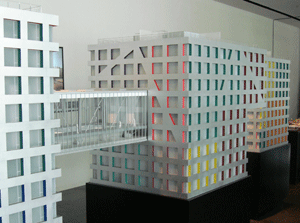Silksters Galleries - Weaving
Weaving with silk is fantastic!. If you've not woven with silk than you're missing out.
This Silksters Weaving are presents some of Treenway Silk's customers wonderful projects using silk.
- Marguerite Band, Shawl
- Jean Korus, Shawl
- Karen Ely, Shawl
- Jean Johnson, Shawl
- Kathy Erskine, Shawl
- Doreen Page, Kimono
- Kathleen Morris, Woven Shibori
- Dorothy Solbrig, Woven Jacket
- Deb Turner, Woven Silk/Yak Scarves
- Jean Bair, Woven Jacket
- Bobbie Kelsten
- Jean Korus, Muga Silk Scarf
- Els van Dam, Natural Dyed Silk Scarves
- Abra Palumbo - Wedding Shawl
- Susan Harvey - Scarf
- Marion Marzolf - Confetti Scarves
- Melanie Nakashima Scarves
- Helen Wider - Scarf
- Sue Willingham - Scarf
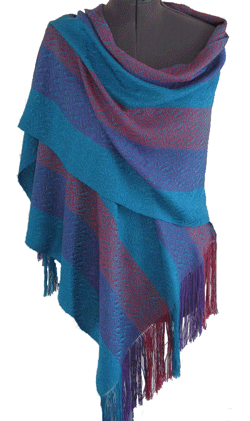
Weaving Infomation
Width: 24 inches
Warp Length: 3½ yards
EPI: 24
PPI: 20
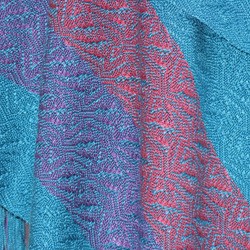
Marguerite Band, Nanaimo, British Columbia
Paua Shell Silk Shawl
Marguerite sent us an image of her gorgeous shawl and we could feel her excitement when she wrote, "I would like to share with you my delight in receiving 3rd place prize in the accessories category for my Paua Shell Silk Shawl at the Vancouver Island Fibre Arts Showcase in September 2010."
Marguerite says, "The glowing swirl of colours of the New Zealand paua shell was my inspiration for this handwoven shawl. To capture these colours and their luminosity, I hand dyed Treenway Silks 12/2 in blue violet, blue green and blue red using Landscape dyes from Australia. To weave this piece I chose a 6 shaft modified twill draft and a single colour weft to unify the 3 coloured warp and to bring out the swirling flow of colour that I sought.
I love the luxury of silk. As a shawl this piece is both cool and warm, an elegant accessory for evening wear, and with blue jeans for a more casual setting."
Jean Korus, Moscow, Idaho
Silk Scarves
Jean has been a weaver and friend for many years. She also confessed years ago, that she would not take on spinning because there were not enough hours to do all the weaving she had in mind. Well, this is what Jean says about her spinning now, "I use the spinning as a reward for getting other things done. It has really been fun."
All of the scarves are woven on a 24 shaft point twill with Treenway's 20/2 spun silk for the warp and handspun silk fibre from Treenway's Salt Spring Island Series for the weft. The sett is 30 epi. The weft is a singles yarn to show off the beautiful colours. It was wonderful to spin! I tried to keep the colors in order when I did the spinning and the weaving. I wound off all the bobbins for the weft and then started with the last one first. It helps to number them. I think I used 3 bobbins per scarf. I hand washed the finished scarves and gave them a hard press to bring out the sheen of the silk."
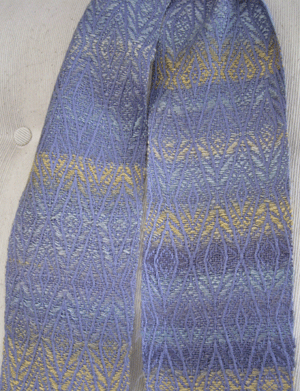
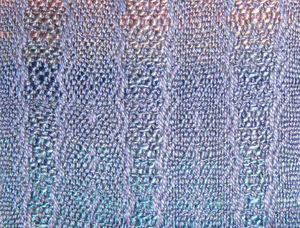
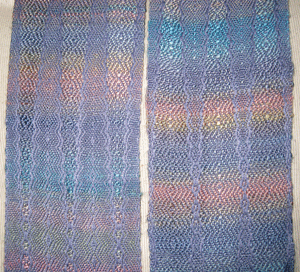
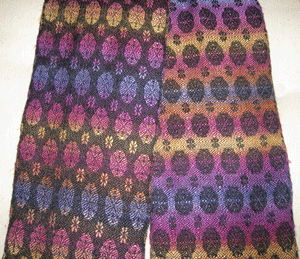
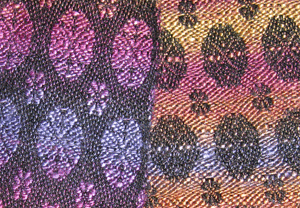
Karen Ely, Salt Spring Island, British Columbia
Silk Shawl
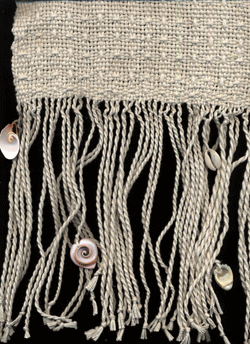
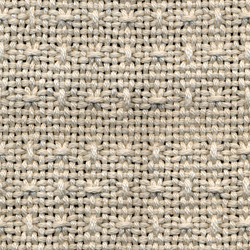
Six months ago I started work at Treenway Silks where a new world opened up to me. With the job I got the bonus of learning how to weave from Karen.
The shawl is my second piece of weaving. I found a pattern called Swedish Lace which I altered by sleying one thread per dent rather than two per dent. The warp and weft are both 20/10, sett at 10 epi. While twisting the fringe I added some shells which have given a nice weight to the drape. I am sending the shawl to my 80 year old mother for her birthday.
What an honour it is to have been taught such a wonderful skill and to be able to create a thing of beauty with your own hands to become a loving gift. It is with loving kindness I also thank my teacher.
Jean Johnson, Chapel Hill
Gebrochene Twill
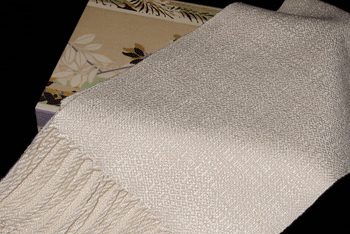
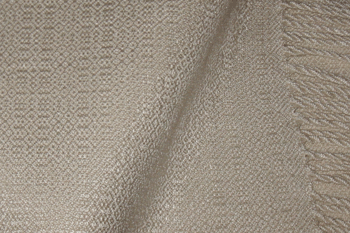
We were wowed by Jean's scarf. She had only been weaving for three years when she completed this scarf. So this should be an inspiration to everyone just starting out. This is what Jean says about her scarf.
The 20/2 silk for the scarf was sett at 30 epi, with a total of 233 ends for the pattern and 4 ends used as double floating selvedges. Threading and treadling were according to the "earl's canvas draft" reduced to four shafts. This Gebrochene twill, originally worked on 14 shafts, is described in detail by Marjie Thompson in Twill Thrills, The Best of Weaver's, edited by Madelyn van der Hoogt. The finished dimensions are 6" x 57" plus the twisted fringe.
I wove the scarf for the 2009 Christmas exchange of the Chapel Hill Handweavers Guild (with a specific recipient in mind, selected months earlier). Members of this guild helped me wrp my first loom and have encouraged me every stop of the way. This was my first attempt at weaving with silk – I enjoyed the process thoroughly and appreciated Karen's detailed suggestions for working with this lovely fiber.
Kathy Erskine, Elkhorn, Wisconsin
Sequined Shawl
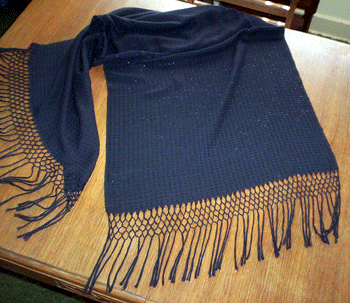
We enjoyed seeing Kathy's gorgeous shawl and learning how she made it.
Some time ago I ordered 60/2 silk dyed black through my local yarn shop. It had to be specially dyed and Treenway was the only one that would take on the task. The results were wonderful and enabled me to weave the sequined shawl that I had fallen in love with when I saw it in Handwoven magazine (Jan/Feb 2002, draft by Sigrid Piroch).
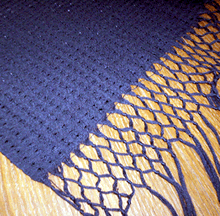
The shawl is woven to create tiny pockets using a double weave structure on eight shafts. A sequin is placed in each pocket and then woven closed. The finished shawl sparkles when light hits the sequins and puts forth a mesmerizing appearance. The Treenway yarn was a pleasure to weave with. While very fine, the yarn is strong and I never had a broken warp thread to frustrate me. The finished shawl has that unmistakable silken hand and drape.
One tip I must share will save any weaver's leg muscles: When at the point where the sequins are added, use some sort of object to hold up the shafts which are raised for that pick. I used two Styrofoam blocks which allowed my legs to relax while it took several minutes to place each sequin across the row.
Doreen Page, Sutton, Quebec
Kimono
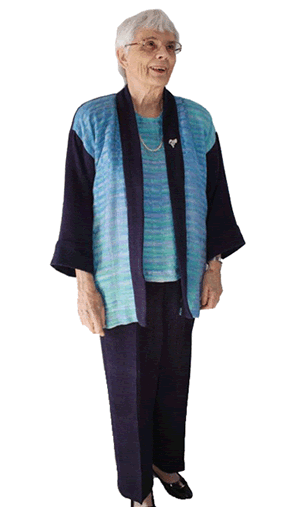
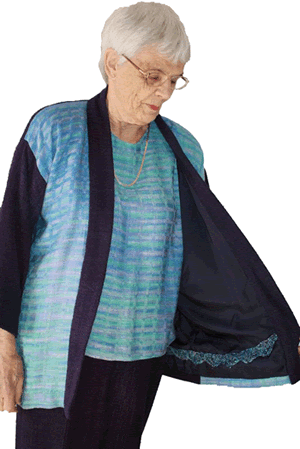
This absolutely stunning kimono outfit has been in the making for a number of years. I have been privileged to be a distant part of the process. It all began when I was going to give a workshop in Vermont at a retreat quite awhile ago. For the first time in my teaching career, I was stranded due to snow and could not make the first day of the workshop. I finally arrived the second day at 1am. A group of amazing women from Quebec waited up for me with red wine in hand and that was the beginning of a long and lovely friendship. This introduction will help provide the background to what Doreen has to say about her lovely outfit. Finally, I am taking a minute to send photos of my kimono jacket, blouse and pants that have been many years in the making. I think I bought the first couple of skeins of natural silk from you when I attended the workshop in Vermont. Remember the storm that stranded you in Boston? I bought more when you came to do a workshop with us in Sutton, Quebec. When I did the calculation and planning for the outfit, I sent for the remainder of the yarn. After another hiatus, I got to the dyeing. The painted warp for the blouse and kimono fronts was fine, but I ran out of dye for the purple. I had to redye, so I have variations in the colour, it is interesting, like imperfect handspun! About a year ago I got to the cutting stage, and that was a challenge as there had been more shrinkage than expected (sample, sample!). I didn't get around to the sewing until spring or early summer, but just had to get it done to enter in our guild's exhibit for our 25th anniversary celebration in August 2009. You'll laugh at the reason for the knitted trim on the lining of the jacket. Too much time had lapsed since I cut out the pieces and when I went to put the lining together I put the rectangle in the wrong way for the back of the jacket. Thinking I had just added too much "ease", I cut off the excess and only then discovered my error and the back was then too short. Rather than take it all apart, cut a new piece and start all over, I merely disguised the seam with the knitted lace and a few beads. I have worn the outfit twice and find it very comfortable. I am looking forward to the next occasion when I can wear it again.
Kathleen Morris, Toronto, Ontario
Woven Shibori
The colour and texture of Kathleen's shawls took our breath away. She tells us, "In recent years I've worked almost exclusively with woven shibori. The term describes a technique by which a supplementary weft thread is woven alongside the ground cloth. This thread – generally strong and slippery in nature – is bound tightly after the cloth is woven, turning the flat fabric into a compressed bundle which is ready for dyeing, discharging, and/or painting. The supplementary thread is then removed, revealing a plain woven cloth with dyed traces of woven pattern."
"The technique fuses weave structure with surface design, allowing for bold woven pattern to be applied to a cloth with dye. My work uses these fabrics in combination, collaging patterns from different warps and interspersing woven cloth dyed by other methods, all referencing the loom and the process by which they were made."
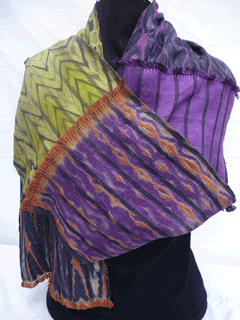
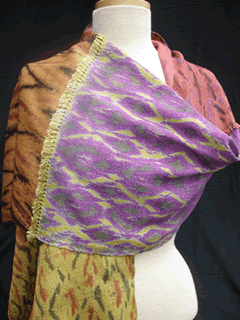
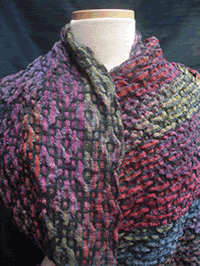
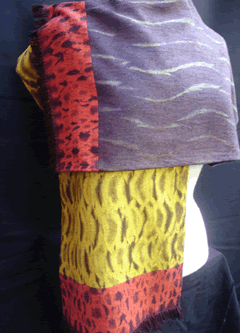
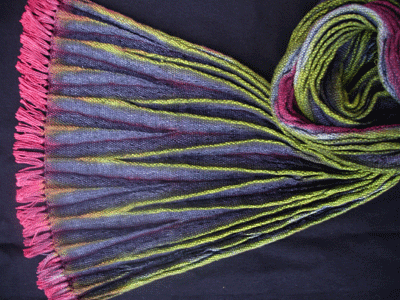
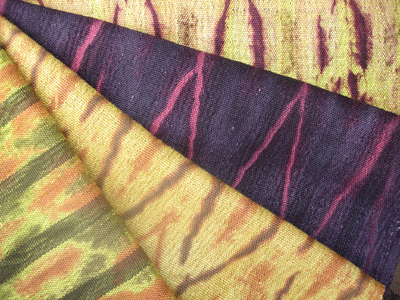
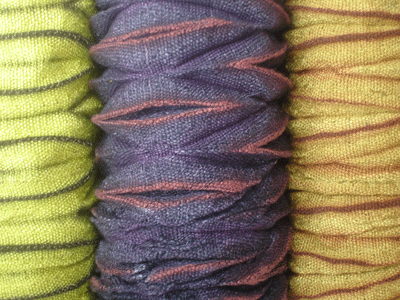
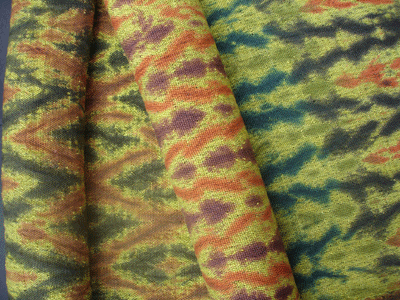
Dorothy Solbrig, Harvard, Massachusetts
Woven Jacket
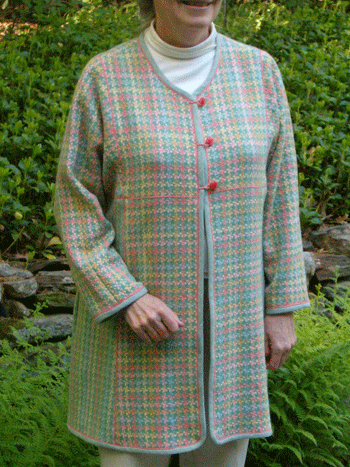
It was very exciting to receive Dorothy's photo. I don't often get a chance to see the outcome of what we start in a workshop and her jacket is divine. Dorothy tells us, "I wanted to make my daughter a jacket and she picked out the sample from our Silken Kaleidoscope workshop. My version is considerably simplified compared to our original Monet's Garden.
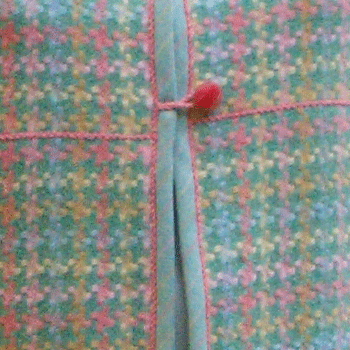
My daughter wanted a jacket with Empire lines, similar to one she had seen in a store. I modified a pattern to get the lines and length she wanted. I wove the bias tape binding the edges in a doubleweave tube, as suggested by Jean Scorgie in Weaver's Craft, issue #10 (2001). The tube is cut on the bias, giving a long bias strip without seams. I made a twisted cord for accent.
I entered the jacket in NEWS (New England Weavers Seminar) in 2007, and called it "Monet's Garden Revisited" in honor of the source of inspiration. The jacket won first prize in the category for jackets woven on more than four shafts and an additional prize for use of nontraditional fiber."
Deb Turner, Alberta
Woven Silk/Yak Scarves
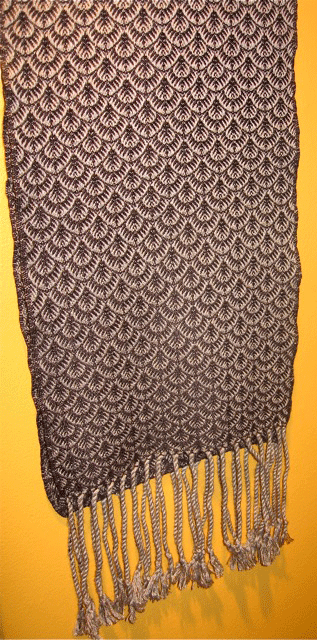
We had already seen how exquisite Deb's scarves were at the conferences in Alberta and we are thrilled to share them with you.
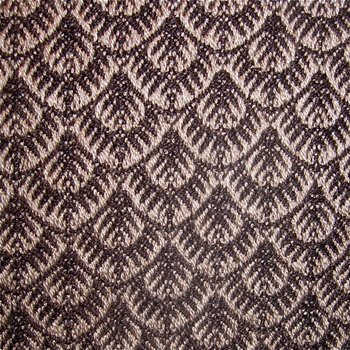
"These particular scarves are born out of a desire to produce items for not only women but also men. I'm a member of an art co-op with two sales a year and see many people touch and play with my work. My first sale was two years ago and I had 20 bamboo shawls. Men loved to feel them, but they were styled for women. Knowing the yak/silk was so great to work with, I played with designs and now have six different patterns on file. I weave these with either black 30/2 silk or natural white 30/2 and can never have enough on hand. It is a pleasure to be able to market items made with such high quality fibres and often introduce people to their first purchase of a handwoven item."
Jean Bair, Petawawa, Ontario
Al's Jacket
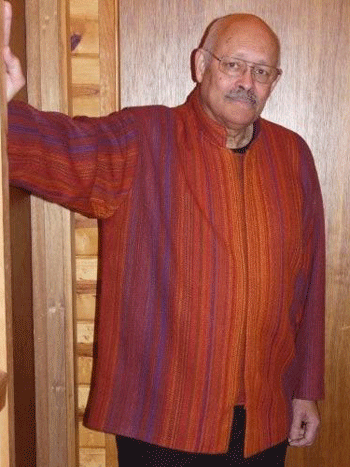
We were thrilled to see Jean's very special jacket for her very special guy.
"For years, I intended to weave something special for Al. When his 75th birthday was approaching, it seemed urgent to begin. The autumn of our lives, and an October birth date, suggested a colour scheme that seemed appropriate. In the midst of planning, we made a trip to Africa; the Kente cloth of Ghana, woven in narrow strips was the inspiration for the twill block design in the back of the finished jacket. Colour was the most challenging aspect of the designing process, but also the most satisfying when finally the many colours came together."
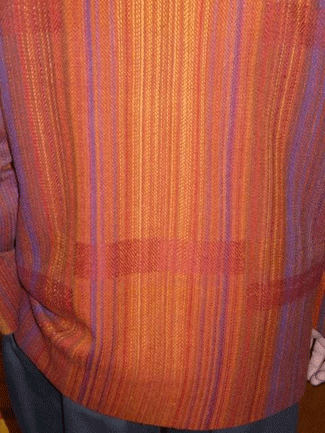
"Al's jacket became a group project as my weaving friends offered advice at each and every decision-making stage. There were so many gorgeous colours from which to choose. When I added a touch of indigo and purple to the russet, gold, orange and red mix, with a deep red shiny 20/2 silk weft, everything worked. The yarns were all from Treenway. Most were silk noil, the rest 20/2 and 30/2 spun silks chosen for colours."
"Weaving was a pleasure after all the agonizing and decision-making that came before the weaving. Turned twill, or two twill blocks on 8 harnesses made broad horizontal stripes in the back, to suggest that there were three strips with borders joined together, although it was woven as one."
"Finding the perfect wooden buttons and silk satin lining was important. Sewing the jacket after many years of NOT sewing in order to weave was another challenge. Thank goodness I found my old Vogue Sewing Book to refresh my memory, as I attempted to incorporate all the couturier details!"
"All in all it was a satisfying and enjoyable project."
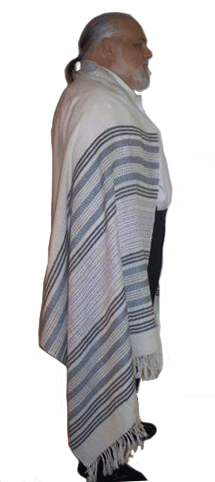
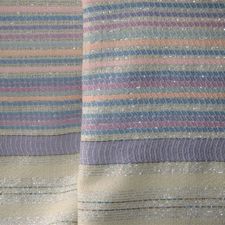
Bobbie Kelsten, Asheville, North Carolina
Tallitot
We really liked what Bobbie had to say about her work. As she weaves her Tallitot (Jewish Prayer shawls) she hopes the wearer will feel "wrapped in the light of prayer."
Bobbie explains her work:
I like to use a combination of several types of yarn: Bombyx 60/2, cashmere/silk, wool/silk and angora/silk. I use a sectional beaming method and wind spools of each type and then rack them in a semi-random order. The body of the shawls is woven in plain weave. After washing the fabric, I get a wonderful crepe effect. The stripe designs are 8 shaft twills.
She is happy to answer questions or do custom orders. You can reach her at bobbiekelsten@bellsouth.net
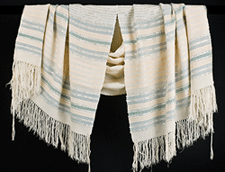
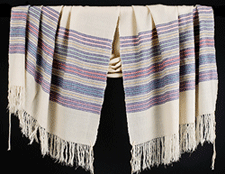
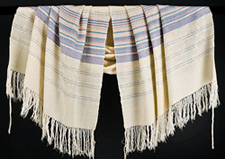
Jean Korus, Moscow, Idaho
Bombyx & Muga Silk Scarf
We think a sigh of 'wow' will leave your lips when you see Jean's exquisite scarf as it did for everyone around here.
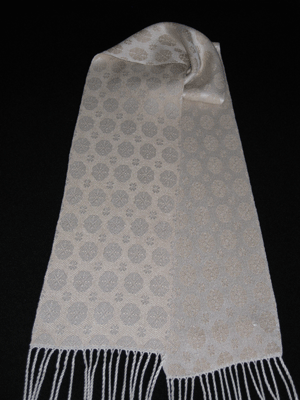

Jean tell us:
My favorite material to weave with is silk. Both the 20/2 and Muga silk were very easy to weave with. I was inspired to weave with the Muga after taking a trip to Assam, India with Karen Selk and Michele Wipplinger to see where the silkworms live and how the cocoons are processed into yarn. The yarn has a wonderful shiny golden color that is a joy to watch emerge as I weave. I feel I am weaving with gold threads!
The warp is 20/2 natural silk, sett at 28 epi. The weft is the Muga silk. Both were very easy to work with. The pattern is a 24 shaft point twill. I think the Muga makes a very elegant scarf, which is why I ordered more!
Els van Dam, Mill Bay, British Columbia
Natural Dyed Silk Scarves
Els is one of the special people that we are fortunate enough to see in person every so often. She is extremely creative as you will see.
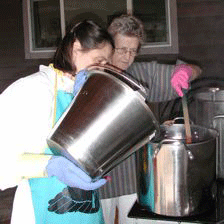
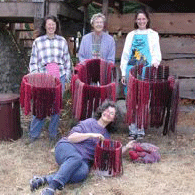
She explains about the scarves:
I dyed the silk in Brazil wood and gave one to my oldest daughter, Peggy and one to my ex-daughter-in-law. The shawl is 18 inches wide using skeins of deep purple, mauve and lighter lilac fine silk. The weft was silk, naturally dyed in an indigo bath done in the eighties with a group of Toronto spinners and weavers. I used a big shuttle that holds two bobbins and wove it in a 12 shaft undulating twill.
When I lived in Toronto, a group of guild members would meet once a year at Karl Khomeyer's cottage. Karl would have all the dye baths going in big copper pots, old fashioned tin washing pots as well as one huge cast iron soup pot so we could start work when we arrived at 9am. The cast iron pot was so big you could have a bath in it. Around 2 we would break for a huge wonderful home cooked lunch, prepared with great care by Gordon, Karl's partner. The dessert was always a delicious trifle, laced with brandy and topped with dollops of whipped cream. While sipping our wine, Gordon would give an organ recital, putting us all to sleep. Those were the good old days, in the mid eighties. Phil, who is in her nineties now and still going strong, would drive us home again while I sat next to her and just talked non stop so she would not fall asleep on the 401, while the other girls in the back would be peacefully sleeping away; those were the days indeed.
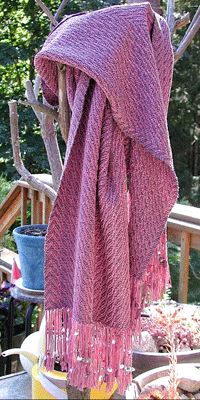
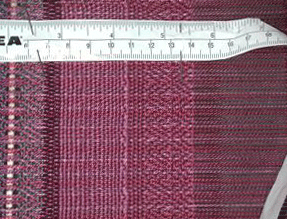
I have continued this tradition of having an outdoor fun day during the summer months at our house. The Fermanbuk (Caesalpinia) or Brazilwood dyeing is a recipe I use out of a Dutch dyeing book written by Let van de Vrande in 1980. You will find the same recipes in Trudy van Stralen's book Indigo, Madder and Marigold. We get 18 different shades, by pre-mordanting, and mordanting after the dye bath. In addition, we use rinses with vinegar and ammonia. It is a wonderful way of getting different colours from one dye plant and one dye pot.
Shop Treenway Silks Natural Dyeing
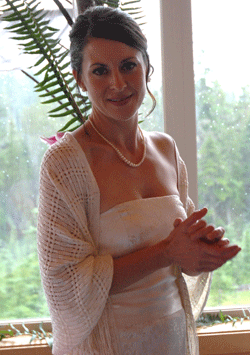
Abra Palumbo, Black Creek, British Columbia
Wedding Shawl
The wedding shawl that Abra made for her daughter was a real collaboration of ideas and choices. It sounds like they had fun together in its making.
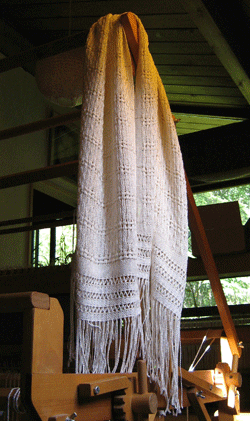
Abra tells the story:
Our daughter chose a beautiful eggshell white, strapless, fitted satin dress with gold and silver brocade for her wedding last summer. I wanted to weave something for her special day. We decided on a shawl to go with the dress to give her some warmth as the day turned to evening. She wanted something sheer and lightweight, as she has a delicate frame and the wedding was in August. We worked carefully, considering the dress as we chose fibres which would be complementary and reflective of the qualities and tones in the dress fabric. We decided to use several silks for the warp: 8/2 reeled silk to match the sheen and luxurious feel of the satin, boucle silk to add texture which was similar to the brocade in the fabric and a gentle 12/2 spun silk for the weft to maintain the lightweight feeling of the fabric. We also incorporated bamboo to give the shawl a bit more body and variance to the color. A metallic gold thread between pattern repeats added some sparkle to echo the metallic in the brocade of the fabric. Now all we had to do was choose a weave structure!
After consulting with guild members on our fibre choices, huck lace was strongly suggested. We used Madelyn van der Hoogt's The Best of Weavers - Huck Lace to make our structure choice. My daughter was struck by the beauty of the pattern designed as "huck lace border" for an overall pattern. The complexity of the pattern felt almost overwhelming to me, but with sampling and practice I was able to gain confidence. We decided on several rows of "trelliswork" at the ends of the shawl to accentuate the lacy effect of the huck Silk shawl by Abra Palumbo structure and to add delicacy to the long fringes and a plain weave border all around for structural strength. Much sampling was needed to decide the sett and techniques for handling the threads. I had the challenge of fitting three fibres symmetrically into two 5-thread huck blocks in the warp and balancing the color and fibre. I learned to set each pick gently and change shed before lightly placing it with the beater. I absolutely loved working with the silks! My daughter and I were both happy with the results. It is a keepsake for a beautiful daughter from a special day to remember for a lifetime.
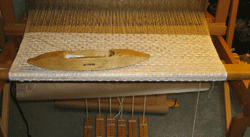
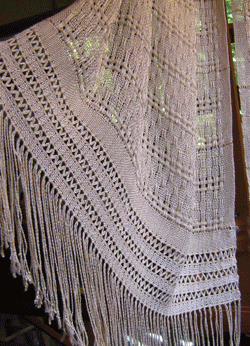
Weaving Infomation
Warp: |
Silk Boucle (Treenway Silks) |
Weft: |
12/2 Spun Bombyx Silk (Treenway Silks) |
Sett: |
12 epi |
Loom: |
4 shaft counterbalance Woolhouse |
Finished: |
19" wide |
Pattern: |
Huck Lace Border |
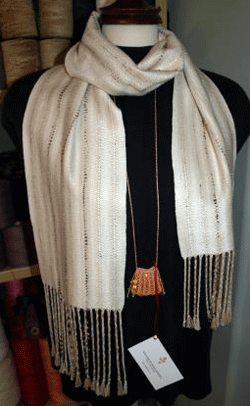
Susan Harvey, Duncan, British Columbia
Wild Silk Scarf
Susan tell us about her interesting blend of silks used in this scarf:
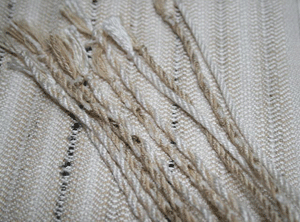
The scarf is a mixture of the various silks I have bought from Treenway over the years: muga, tussah, some reeled, silk noil, silk chenille and creamy spun silk. It was arranged in a repeating sequence, sett at about 24 epi in a repeating twill. The weft is 12/2 spun silk.
I put on enough warp for two scarves. One was for myself and seems to accent most things I wear. I enjoy the compliments I get on it. The other scarf used a gold noil silk as weft and was bought by a classy gent to wear with a winter top coat.
While I have dabbled in tencel and some of the other luxury fibres out there...I keep coming back to silk!
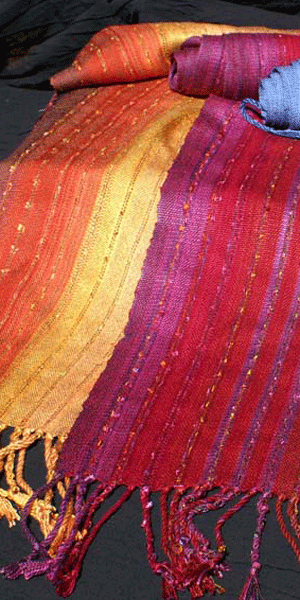
Marion Marzolf, Ann Arbor, Michigan
Confetti Scarves
Marion grew up watching her Swedish-born grandmother weaving rag rugs at her farm in Michigan. She took her first weaving class in 1972 with Joyce Jones in Ann Arbor, Michigan, but soon learned that a university professor had little time for that. When she retired in 1995, weaving and writing about weaving became her prime activities.
She has written several articles featuring other fiber artists. She collaborated with Marie A. Gile on the book Fascination with Fiber: Michigan's Handweaving Heritage, (1976) published by the University of Michigan Press. She is outgoing president of the Ann Arbor Fiberarts Guild www.annarborfiberarts.org and has her studio in Chelsea, Michigan.
Marion shares:
When I saw the colorful Eros ribbon in our local knitting shop, I bought some and knitted a lacy scarf. But I kept thinking that there must be a way to use it in weaving and still retain its sparkling appearance. After some experimentation, I came up with this design that I call Confetti. I used 20/2 Treenway silk for the warp and weft, sett at 24 epi and in plain weave, except the eros stripes are in double weave in order to get the ribbon on front and back. The first scarf I made had the ribbon showing only on one side, and when it flipped in the wind, the sparkle was hidden. These scarves can be hand-washed, dried on a towel, and steam-pressed. They have been popular sellers at our guild booth and local art center. I have used Treenway silks for my block twill scarves and vests and in some hangings. My other fiber love is wool for rya rugs, shawls, and stoles.

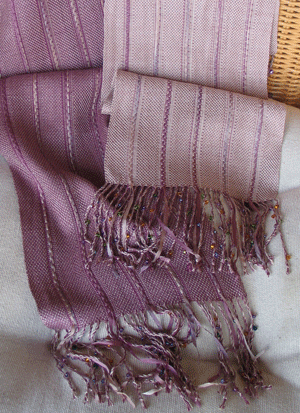
Melanie Nakashima, Spicewood, Texas
Scarves
We loved looking at Melanie's scarves when then arrived via email. She told us a bit about their making.
Melanie tells her story:
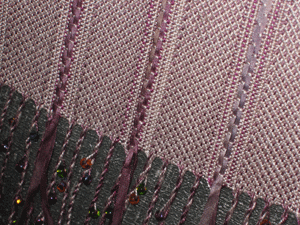
I visited Salt Spring Island in summer of 2005 and made a trip to Treenway. It is a yarn lovers dream to see all the gorgeous yarns and colors. I picked up the yarn I used for this project along with some other beautiful reeled silk.
The scarves are a mix of plain weave and 2/2 twill. I especially loved the delicate many–hued silk ribbon, so I designed the scarves to have the ribbon float alternately over seven picks. The warp was 30/2 spun silk in Evening Spirit #9510 and Sand Dune #9517; 20/2 blue violet spun silk and variegated 3.5mm silk ribbon in mauve, lavender and violet hues. I wove one scarf with Evening Spirit and one with Sand Dune." The finished scarf is 57" x 7 ½" with a beaded, twisted fringe.
I love weaving kitchen towels, fuzzy afghans and large rugs, so I was not used to silk, but I found the yarn to be very amenable. I loved the feel of the luxurious silk – to weave and to wear. I really enjoyed making these scarves, one for myself and one for a gift.

Helen Wilder, Mosman, New South Wales, Australia
Fruit from the Forest, Scarf
We asked Helen to tell us a bit about herself....
I went to a Textile college in Sydney many years ago to do a three year course in Craft Textiles. Four years ago I joined a Craft Co-operative called the Arts & Craft Society of NSW www.artsandcraftsnsw.com.au. We have a shop in the heart of Sydney in the Rocks. I now concentrate on making scarves and shawls. I love the fine silk for its lustre and drape.
I dye most of my warps and get my inspiration from nature or pictures in magazines. I did this scarf for an exhibition in our gallery. The back ground green with touches of gold and red are inspired by the Australian bottle brushes and their red berries. I wove it using 30/2 silk using 8 shafts in a block weave like the Scandinavian 'Drahl'. I love this weave because you can vary the blocks endlessly.
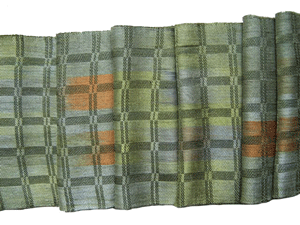
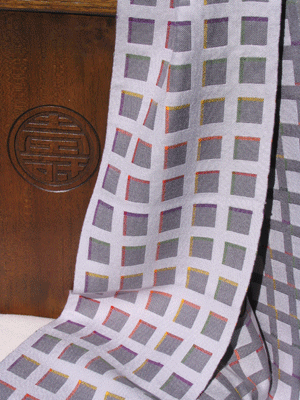
Sue Willingham, Vashon, Washington
Double Weave Windows
We knew Sue's scarf was going to be in Handwoven magazine, so we patiently waited for it to be published so we could include her innovative piece in our gallery.
Sue describes her process best:
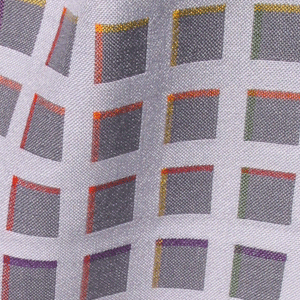
I started weaving in 1997 after my daughter, Janet Dawson of Sydney, Nova Scotia, had learned to weave. She was so enthusiastic about it that I enrolled in a class and that was all it took! Now she weaves and teaches weaving on her island (Cape Breton Island, NS) and I weave and teach weaving on mine (Vashon Island, WA) and we share often over the phone, by email and very occasionally in person.
This scarf was designed and woven as a gift for a former banking client who included me in a wonderful ten–day tour of Eastern China. I was watching for inspiration as we toured, and when I saw the model of the Grand MOMA complex in Beijing, I remembered that double–weave could be used to design 'windows.' By using two tones of gray, the lighter for the building and the darker for the windows, and adding bands of colour on two sides of the windows, the design of the scarf reflects the structure of the building. My China tour host calls it his 'architectural scarf.'
The first scarf I wove was sett at 60 epi, with 30epi in each layer. When I wove the second scarf, I loosened the sett slightly to 56 epi (28 per layer) and found that the drape was nicer. The gray yarns are 30/2 spun silk that I found at Treenway. I had bought some silk floss in Suzhou, China, which I used for the yellow, red and orange accent colors; for the purple and green I used Treenway's 20/2 spun silk in 10 yard mini skeins which worked fine. I found that keeping the layers separate when I hemstitched the fringed ends was much neater looking than hemstitching the layers together. The complete instructions for this scarf are in the May/June 2007 issue of Handwoven magazine on pages 72-74.
